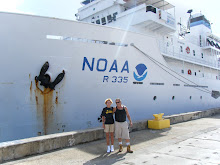 The past two days have been spent working with the Autonomous Underwater Vehicle. On Sunday, the AUV was put in the water but never set free because it was having communications problems. On Wednesday, it was communicating perfectly, but just as it was to be released, the last line holding it to the ship became entangled and The AUV had to be brought back aboard. The afternoon deployment went perfectly. The AUV stayed on track for about two hours. It brought back pictures and video but I haven’t seen them yet.
The past two days have been spent working with the Autonomous Underwater Vehicle. On Sunday, the AUV was put in the water but never set free because it was having communications problems. On Wednesday, it was communicating perfectly, but just as it was to be released, the last line holding it to the ship became entangled and The AUV had to be brought back aboard. The afternoon deployment went perfectly. The AUV stayed on track for about two hours. It brought back pictures and video but I haven’t seen them yet.There are many different kinds of AUVs. The AUV being used on this trip is called the SeaBed from Woods Hole Oceanographic Institute (WHOI). It can be programmed to fly slowly or hover over the seafloor to depths of 6,000 feet. It is used to gather detailed sonar images and pictures of the seafloor.
http://www.whoi.edu/page.do?pid=10078
Retrieval
WHOI's newest vehicle is the Nereus. Nereus is actually a Hybrid Remotely Operated Vehicle (HROV). It can operate autonomously or by remote control. In May of 2009 it explored the depths of the Marina Trench at a depth of almost 7 miles. This was only the third time man has been able to see the deepest spot on Earth.
http://www.whoi.edu/page.do?pid=10076
AUVs are an excellent tool to explore depths not easily accessible to divers. Although they are expensive and sensitive high tech machines, they are not as expensive as Remotely Operated Vehicles (ROVs) and manned submersibles.




4 comments:
Hi Ms. Tatreau!
I'm sure youre having a GREAT time out there. I'm curious as to what a CTD stands for. Also, how many scientists are aboard? Cant wait to hear more about it as you progress. Have fun!
toni-5
Hi Toni,
There are 41 people onboard; 22 ship’s crew and 19 scientists (that includes me). CTD is an acronym for Conductivity, Temperature and Depth. It is a tool to determine these physical properties of sea water. We are using a single CTD on this cruise, but multiple CDTs can be attached to a circular frame and take samples at multiple depths. Scientists can use the conductivity and temperature to determine the salinity. The CTD stores the data which is downloaded when it is brought back to the ship. The map-makers use this data to accurately interpret the mutibeam sonar data.
Great pictures and info. I clicked the site for the AUVs and they all look awesome. Can't wait to see the pictures and video that the Seabed took.
Ritzmar-5
Ritz,
You are our most Fish 250 follower. The AUV SeaBed was deployed at 8 P.M. last night and spent about 4 hours taking still pictures of night time activity (or inactivity as the case may be). I haven’t heard about the results yet but I will let you know when I do.
Hello again Ms.T
I hope the trip is coming along great.I know u are having a blast on the boat. lol i wish i could say the same with us doing the work u gave us. even i am having a hard time but its ok. that video was really cool i wish it was in color i saw some fish just when it hit the bottom. when are you going to post pictures. i wish i could have seen that spotted eagle ray
well thats it for now. Stay safe and i'll will see you soon.
Hi Juan,
Yes, that video clip was fun with the BotCam catching the stern of the ship with the propellers and then fading into the bottom. More video footage is going to take a while. We are sending down ten sets of cameras twice a day. That takes up all the daylight hours. Then they have to download the video and get ready for the next day. There is not much time to actually watch the video and even less time to clip out some for the blog. I’ll get it to you as soon as they can get it to me. There will be several more days like this before we can clip the good stuff like the sharks, rays, barracuda and other fish.
Hi Ms. Tatreau!
I've only been be Mr. LeGrande for a day then I left to Japan, remember? I saw the video, I thought it was pretty amazing! You're so lucky (: Have a safe trip on your excursion and I'm looking forward to hear more stories!
Monica-3
Hi Monica,
Yes, life at sea is great fun and I am learning so much. That video you watched was a very lucky shot. Usually the camera going down is just facing open ocean. I hope to get fish videos up soon but the camera people are putting out ten sets of cameras twice a day so they aren’t having much time to watch the videos or make clips for the blog. I trust you are having fun in Japan.
Post a Comment